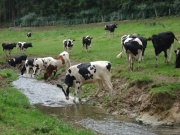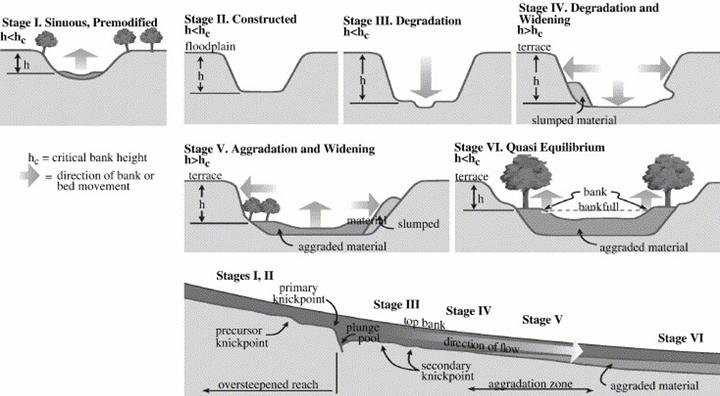Difference between revisions of "Reduce erosion"
(→Reduce erosion) |
(→Useful references) |
||
| Line 25: | Line 25: | ||
<Forecasterlink type="getProjectsForMeasures" code="M13" /> | <Forecasterlink type="getProjectsForMeasures" code="M13" /> | ||
==Useful references == | ==Useful references == | ||
| + | Kondolf, G. M. (2006) River restoration and meanders. Ecology and Society 11: 42, http://www.ecologyandsociety.org/vol11/iss2/art42/ | ||
| + | |||
| + | Myers, T., Swanson, S. (1995) Impact of deferred rotation grazing on stream characteristics in central Nevada: A case study. North American Journal of Fisheries Management 15, 428-439. | ||
| + | |||
| + | Simon, A., M. Doyle, M. Kondolf, F. D. Shields, B. Rhoads, McPhillips, M. (2007) Critical evaluation of how the Rosgen classification and associated “Natural Channel Design” methods fail to integrate and quantify fluvial processes and channel response. Journal of the American Water Resources Association, JAWRA 43, 1117-1131. | ||
| + | |||
| + | Summers, D. W., Giles, N., Stubbing, D. N. (2008) Rehabilitation of brown trout, Salmo trutta, habitat damaged by riparian grazing in an English chalkstream. Fisheries Management and Ecology, 15, 231-240. | ||
| + | |||
==Other relevant information == | ==Other relevant information == | ||
'''Evolution of incised channels:''' Several conceptual models have been developed for the evolution of deep or incised channels (e.g. Schumm et al. 1984, Simon and Hupp 1986, Simon and Rinaldi 2006). These models can be used to assess the present stage of the river reach, which further morphological changes probably occur, and to select appropriate restoration measures. For example, if the reach is already downstream from the knickpoint and starts to widen (Fig. 1 stage IV), it might be an appropriate restoration measure to increase sediment deposition since there will be an increasing sediment input from upstream. Therefore, it is crucial to consider the state of the upstream and downstream reaches and to involve some geomorphological expertise in the restoration project. | '''Evolution of incised channels:''' Several conceptual models have been developed for the evolution of deep or incised channels (e.g. Schumm et al. 1984, Simon and Hupp 1986, Simon and Rinaldi 2006). These models can be used to assess the present stage of the river reach, which further morphological changes probably occur, and to select appropriate restoration measures. For example, if the reach is already downstream from the knickpoint and starts to widen (Fig. 1 stage IV), it might be an appropriate restoration measure to increase sediment deposition since there will be an increasing sediment input from upstream. Therefore, it is crucial to consider the state of the upstream and downstream reaches and to involve some geomorphological expertise in the restoration project. | ||
Revision as of 16:12, 25 June 2015
Contents
Reduce erosion
Category 02. Sediment flow quantity improvement
General description
Erosion and deposition of bed and bank material are natural processes in rivers. However, excess bed and bank erosion leads to channel incision and lateral instability and excess input of (fine) sediment, respectively.
Excess bed erosion: Incised channels occur when stream power exceeds the channel bed’s resistance, or when sediment output exceeds the sediment input to the reach (sediment deficit). Bed erosion can be reduced by restoration measures described in other fact-sheets: either by restoring a more natural flow regime (Modify hydropeaking, Reduce anthropogenic flow peaks) or reducing the sediment deficit (Add sediment, Manage dams for sediment flow).

Excess bank erosion: Excess bank erosion increases the input of fine sediment, clogging interstitial spaces and limiting spawning success of fish and habitat for macroinvertebrates, and filling pools. The restoration measures should first try to address the causes for excess bank erosion like reducing non-natural peak flows (Modify hydropeaking, (Reduce anthropogenic flow peaks) or livestock fencing to reduce stream bank trampling damage. If habitat conditions are severely affected by excess bank erosion and the above mentioned measures cannot be applied, river banks may be stabilized using bio-engineering techniques.
Important note: Bed- and bank erosion and deposition of sediment are natural processes needed to develop and sustain a natural planform and channel features. Therefore, many restoration projects aim at initiating natural morphodynamics rather than limiting it (Initiate natural channel dynamics). The paradigm of the “stable channel design”, assuming that river channels should be stable and can be “restored” by creating a desired “stable” channel, ultimately resulted in questionable projects like building meandering channels with fixed banks. This approach has been heavily criticized since it ignores that channels are naturally dynamic, such projects are prone to failure (Kondolf 2006, Simon et al. 2007) and must not be applied.
Applicability
Restoration measures to limit excess bank erosion are especially important in gravel-bed rivers where fine sediment is clogging interstitial spaces and altering habitat for fish and macroinvertebrates. Especially livestock fencing is very easy to implement.
Expected effect of measure on (including literature citations):
- HYMO (general and specified per HYMO element)
- physico � chemical parameters
- Biota (general and specified per Biological quality elements)
Pressures that can be addressed by this measure
- Alteration of instream habitat
- Reservoir flushing
- Sediment discharge from dredging
- Loss of vertical connectivity
- Sand and gravel extraction
- Sedimentation and sediment input
Case studies where this measure has been applied
- Klompenwaard
- Meers - Floodplain lowering
- Doñana. Restauración del arroyo del Partido
- Sella
- Anzur. Intervención de mejora ambiental de un tramo del Río Anzur
- Deva River. Bank protection on the right bank of the Deva River in Molleda
- Upper Woodford - Demonstrating strategic restoration and management STREAM (LIFE05 NAT/UK/000143)
- Lower Traun
- Narew river restoration project
Useful references
Kondolf, G. M. (2006) River restoration and meanders. Ecology and Society 11: 42, http://www.ecologyandsociety.org/vol11/iss2/art42/
Myers, T., Swanson, S. (1995) Impact of deferred rotation grazing on stream characteristics in central Nevada: A case study. North American Journal of Fisheries Management 15, 428-439.
Simon, A., M. Doyle, M. Kondolf, F. D. Shields, B. Rhoads, McPhillips, M. (2007) Critical evaluation of how the Rosgen classification and associated “Natural Channel Design” methods fail to integrate and quantify fluvial processes and channel response. Journal of the American Water Resources Association, JAWRA 43, 1117-1131.
Summers, D. W., Giles, N., Stubbing, D. N. (2008) Rehabilitation of brown trout, Salmo trutta, habitat damaged by riparian grazing in an English chalkstream. Fisheries Management and Ecology, 15, 231-240.
Other relevant information
Evolution of incised channels: Several conceptual models have been developed for the evolution of deep or incised channels (e.g. Schumm et al. 1984, Simon and Hupp 1986, Simon and Rinaldi 2006). These models can be used to assess the present stage of the river reach, which further morphological changes probably occur, and to select appropriate restoration measures. For example, if the reach is already downstream from the knickpoint and starts to widen (Fig. 1 stage IV), it might be an appropriate restoration measure to increase sediment deposition since there will be an increasing sediment input from upstream. Therefore, it is crucial to consider the state of the upstream and downstream reaches and to involve some geomorphological expertise in the restoration project.
According to the channel-evolution model of Simon and Rinaldi (2006) (Fig. 1):
- “One can consider the equilibrium channel as the initial, predisturbed stage (I),
- and the disrupted channel as an instantaneous condition (stage II).
- Rapid channel degradation of the channel bed ensues as the channel begins to adjust (stage III). Degradation flattens channel gradients and consequently reduces the available stream power for given discharges with time. Concurrently, bank heights are increased and bank angles are often steepened by fluvial undercutting and by pore-pressure induced bank failures near the base of the bank.
- The degradation stage (III) is directly related to destabilization of the channel banks and leads to channel widening by mass-wasting processes (stage IV) once bank heights and angles exceed conditions of critical shear-strength of the bank material.
- The aggradation stage (V) becomes the dominant trend in previously degraded downstream sites as degradation migrates further upstream because the flatter gradient at the degraded site cannot transport the increased sediment loads emanating from degrading reaches upstream. This secondary aggradation occurs at rates roughly 60% less than the associated degradation rate (Simon, 1992). Riparian vegetation becomes established on low-bank surfaces during this stage and serves as a positive feedback mechanism by providing roughness that enhances further deposition.
- These milder aggradation rates indicate that recovery of the bed will not be complete and that attainment of a new dynamic equilibrium (stage VI) will take place through further (1) bank widening and the consequent flattening of bank slopes, (2) the establishment and proliferation of riparian vegetation that adds roughness elements, enhances bank accretion, and reduces the stream power for given discharges, and (3) further gradient reduction by meander extension and elongation. The lack of complete recovery of the bed results in a two-tiered channel configuration with the original floodplain surface becoming a terrace. Stormflows are, therefore, constrained within this enlarged channel below the terrace level and result in a given flow having greater erosive power than when flood flows could dissipate energy by spreading across the flood plain.”
Fig. 1 Stages of channel evolution (from Simon and Rinaldi 2006)
Literature on evolution of incised channels:
Simon, A. and Hupp C.R. (1986) Channel evolution in modified Tennessee channels. Proceedings, Fourth Federal Interagency Sedimentation Conference, Las Vegas, March 24–27, Vol. 2,. 5–71 – 5–82.
Simon, A. and Rinaldi, M. (2006) Disturbance, stream incision, and channel evolution: The roles of excess transport capacity and boundary materials in controlling channel response. Geomorphology,79, 361-383.
Schumm, S. A., Harvey, M. D. & Watson, C. C. (1984). Incised channels: Morphology, dynamics, and control. Littleton, Colorado.
